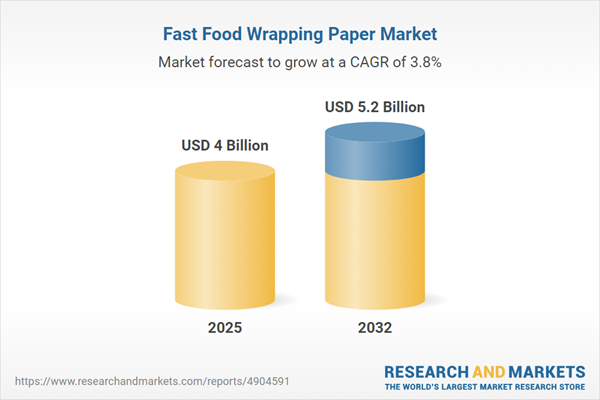Speak directly to the analyst to clarify any post sales queries you may have.
The fast food wrapping paper market is undergoing significant transformation as sustainability standards rise and regulatory oversight intensifies. Senior decision-makers must adapt sourcing and operational strategies to maintain competitive positioning while safeguarding supply reliability and compliance across global operations.
Market Snapshot: Fast Food Wrapping Paper Market
In 2024, the global fast food wrapping paper market achieved a value of USD 3.85 billion and is poised for further expansion, projected to reach USD 4.00 billion in 2025 and USD 5.20 billion by 2032, reflecting a compound annual growth rate of 3.82%. This momentum reflects the proliferation of quick-service restaurants and growing complexity in cross-border logistics. Leading companies are responding to market needs through dynamic procurement models, supporting swift adaptation to regulatory change and shifting consumer expectations. Investments in barrier material innovation, improved supplier compliance methods, and evolving packaging legislation continue to redefine the competitive landscape. Executives focused on strategic sourcing and operational flexibility are positioned to realize distinct market advantages.
Scope & Segmentation
- Material Types: Incorporates options such as aluminum foil, greaseproof paper, wax paper, parchment, coated and uncoated varieties, and PLA film. Each provides moisture resistance, food safety, and aligns with sustainability mandates, supporting varied operational goals.
- Application Types: Supports a wide array of menu offerings—burgers, sandwiches, desserts, and snacks. These materials ensure workflow efficiency, consistent brand presence, and consumer convenience, benefiting both major chains and independent outlets.
- End Users: Encompasses fast food chains, regional cafeterias, institutional canteens, and mobile vendors including food trucks. Each group manages sourcing complexity involving supply scale, continuity, and responsiveness to regional regulations.
- Distribution Channels: Includes direct manufacturer contracts, traditional distributor partnerships, wholesale networks, and digital procurement platforms. Each channel provides unique benefits in terms of supply chain agility, cost management, and transparency.
- Regions: Spans North America, Latin America, Europe, Middle East, Africa, and Asia-Pacific. Variations in procurement needs, regulatory requirements, and consumer preferences drive distinct material strategies and compliance solutions in each region.
- Profiled Companies: Features Berry Global, Amcor, Mondi, Huhtamäki, Sonoco, WestRock, Smurfit Kappa, International Paper, Graphic Packaging Holding, and Pactiv Evergreen as leaders in setting standards for operational flexibility and regulatory compliance.
Key Takeaways for Executive Leadership
- Adopting bio-based and compostable films accelerates progress towards sustainability objectives while enhancing relationships with eco-conscious suppliers and stakeholders.
- Utilizing advanced digital printing technology allows rapid adjustment to changing marketing initiatives and regulatory demands, maintaining compliance and communications agility.
- Integrating logistics strategies into packaging development increases resilience, ensuring businesses can react efficiently to external disruptions or changing regulations.
- Expanding regional manufacturing and diversifying supplier networks mitigates global supply risks and promotes rapid adaptation to local market requirements.
- Prioritizing multi-sourcing strategies, combined with proactive risk assessments, ensures uninterrupted material availability and minimizes exposure to sudden market changes.
United States Tariff Impact
Recent tariffs imposed by the United States have resulted in increased prices for specific inputs, especially metallized films. In response, procurement teams are prioritizing domestic and regional supplier partnerships to offset higher costs and maintain alignment with current U.S. regulatory requirements, while also achieving greater supply chain visibility and risk control.
Methodology & Data Sources
This analysis leverages comprehensive secondary research, direct interviews with procurement leaders, and insight from packaging engineers. Employing a multifaceted methodology ensures results accurately reflect operational realities and inform strategic decision-making in the fast food wrapping paper sector.
Why This Report Matters: Fast Food Wrapping Paper Market
- Enables procurement leaders to assess suppliers rigorously and streamline packaging sourcing decisions under evolving industry pressures.
- Delivers targeted executive insights for effective navigation of regulatory shifts, technology adoption, and operational best practices.
- Arms organizations with the foresight to strengthen compliance and remain competitive as global supply and consumer dynamics shift.
Conclusion
This report equips senior executives with actionable intelligence to reinforce packaging supply chains and adopt compliant, sustainable procurement practices as industry expectations advance.
Additional Product Information:
- Purchase of this report includes 1 year online access with quarterly updates.
- This report can be updated on request. Please contact our Customer Experience team using the Ask a Question widget on our website.
Table of Contents
3. Executive Summary
4. Market Overview
7. Cumulative Impact of Artificial Intelligence 2025
Companies Mentioned
The companies profiled in this Fast Food Wrapping Paper market report include:- Berry Global, Inc.
- Amcor PLC
- Mondi PLC
- Huhtamäki Oyj
- Sonoco Products Company
- WestRock Company
- Smurfit Kappa Group PLC
- International Paper Company
- Graphic Packaging Holding Company
- Pactiv Evergreen Inc.
Table Information
| Report Attribute | Details |
|---|---|
| No. of Pages | 190 |
| Published | November 2025 |
| Forecast Period | 2025 - 2032 |
| Estimated Market Value ( USD | $ 4 Billion |
| Forecasted Market Value ( USD | $ 5.2 Billion |
| Compound Annual Growth Rate | 3.8% |
| Regions Covered | Global |
| No. of Companies Mentioned | 11 |









